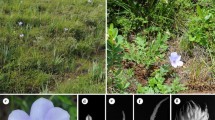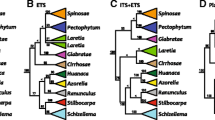Abstract
The Lucilia group sensu Anderberg and Freire comprises nine South American genera: Belloa, Berroa, Chevreulia, Cuatrecasasiella, Facelis, Gamochaetopsis, Jalcophila, Lucilia and Luciliocline. The aims of this contribution were, using DNA sequences from plastid (rpl32-trnL, trnL-F) and nuclear (ITS and ETS) markers, together with morphological characters, to test the monophyly of the Lucilia group and provide new insight into generic circumscriptions. Our studies, including a broad taxon sampling of Gnaphalieae species, suggest that the Lucilia group is paraphyletic, since Antennaria, Chionolaena, Gamochaeta, Loricaria, Micropsis, Mniodes and Stuckertiella are all nested within the Lucilia group. Morphology and molecular analyses combined showed that the traditional generic circumscription of most of the genera (e.g., Berroa, Chevreulia, Chionolaena, Cuatrecasasiella, Facelis, Jalcophila and Micropsis) correlates with the inferred phylogenetic relationships. Conversely, Lucilia and Luciliocline are non-monophyletic. Lucilia is nested in a clade with Berroa, Facelis and Micropsis. Luciliocline is strongly embedded within the clade Belloa pp + Mniodes. Our results are consistent with Dillon’s study that considered Belloa as a montotypic genus (B. chilensis). Luciliocline and the remaining species of Belloa are accommodated in the genus Mniodes, and the necessary combinations are proposed for the expanded Mniodes. All the analyses showed that the monotypic genera Stuckertiella and Gamochaetopsis are in a well-supported clade nested within Gamochaeta, which implies that taxonomic changes are required also for these genera. Internal relationships in the group and the key morphological characters used in the taxonomy of the group, as well as incongruences found between morphological and molecular analyses, are discussed.






Similar content being viewed by others
References
Anderberg AA (1991) Taxonomy and phytogeny of the tribe Gnaphalieae (Asteraceae). Opera Bot 104:1–195
Anderberg AA, Freire SE (1990a) Luciliopsis perpusilla Wedd. is a species of Chaetanthera Ruiz and Pavon (Asteraceae). Taxon 39:430–432
Anderberg AA, Freire SE (1990b) Jalcophila boliviensis, a new species of South American Asteraceae (Gnaphalieae). Brittonia 42:138–141
Anderberg AA, Freire SE (1991) A cladistic and biogeographic analysis of the Lucilia group (Asteraceae, Gnaphalieae). Bot J Linn Soc 106:173–198
Baldwin BG, Markos S (1998) Phylogenetic utility of the external transcribed spacer (ETS) of 18S–26S rDNA: congruence of ETS and ITS trees of Calycadenia (Compositae). Molec Phylogen Evol 10:449–463
Bayer RJ, Puttock CF, Kelchner SA (2000) Phylogeny of South African Gnaphalieae (Asteraceae) based on two noncoding chloroplast sequences. Amer J Bot 87:259–272
Bayer RJ, Greber DG, Bagnall NH (2002) Phylogeny of Australian Gnaphalieae (Asteraceae) based on four sequences, four sequences, the trnL intron, trnL/trnF intergenic spacer, matK, and ETS. Syst Bot 27:801–814
Beauverd G (1913a) Contribution à l’étude des Composées 8(2). Le genre Berroa extrait des Lucilia. Bull Soc Bot Genéve 2(5):210–212
Beauverd G (1913b) Contribution à l’étude des Composées 8(3). Le genre Facelis Cassini (emend. Beauverd). Bull Soc Bot Genève 2(5):212–220
Beauverd G (1913c) Contribution à l’étude des Composées 8(4). Le genre Micropsis DC. (emend. Beauverd). Bull Soc Bot Genève 2(5):221–228
Beauverd G (1913d) Contribution à l’étude des Composées 8(1). Le genre Stuckertiella Beauverd. Bull Soc Bot Genève 2(5):205–209
Bergh NG, Linder HP (2009) Cape diversification and repeated out of-southern-Africa dispersal in paper daisies (Asteraceae-Gnaphalieae). Molec Phylogen Evol 51:5–18
Cabrera AL (1958) El género Belloa Rémy. Bol Soc Argent Bot 7:79–85
Chouksanova NA, Sveshnikova LI, Alexandrova TV (1968) Data on karyology of the family Compositae Giseke. Citologija 10:198–206
Cuatrecasas J (1954a) Synopsis der Gattung Loricaria Wedd. Feddes Repert Spec Nov Regni Veg 56:149–172
Cuatrecasas J (1954b) El género Mniodes. Folia Biol Andina 1:17
Darriba D, Taboada GL, Doallo R, Posada D (2012) jModelTest 2: more models, new heuristics and parallel computing. Nat Methods 9:772
De Jong DCD, Longpre EK (1963) Chromosome studies in Mexican Compositae. Rhodora 65:225–240
Dillon MO (2000) Clasification and phylogeny of the South American Gnaphalieae (Asteraceae). In: Andean Botanical Information System. http://www.sacha.org/Gnaphalieae/Gnaphalieae.htm. Accessed September 2013
Dillon MO (2003) New combinations in Luciliocline with notes on South American Gnaphalieae. Arnaldoa 10:45–60
Dillon MO, Sagástegui-Alva A (1985) New species and combinations in Belloa (Inuleae-Asteraceae). Phytologia 58:392–400
Dillon MO, Sagástegui-Alva A (1986) Jalcophila, a new genus of Andean Inuleae (Asteraceae). Brittonia 38:162–167
Dillon MO, Sagástegui-Alva A (1991) Tribe Inuleae. In: Macbride JF et al. (eds) Flora of Peru, Family Asteraceae: Part V. Fieldiana Bot n.s. 26:1–70
Dillon MO, Sagástegui-Alva A (1992) Sinopsis de los géneros de Gnaphaliinae (Asteraceae-Inuleae) de Sudamérica. Arnaldoa 1:5–91
Doyle JJ, Dickson EE (1987) Preservation of plant samples for DNA restriction endonuclease analysis. Taxon 36:715–722
Farris JS, Albert VA, Källersjö M, Lipscomb D, Kluge AG (1996) Parsimony jackknifing outperforms neighbor-joining. Cladistics 12:99–124
Fernández Casas J, Fernández Piqueras J (1981) Estudio cariológico de algunas plantas bolivianas. Anales Jard Bot Madrid 38:149–152
Freire SE (1986a) Novenia: Nuevo género de Inuleae (Compositae). Bol Soc Argent Bot 24:295–304
Freire SE (1986b) Revisión del género Lucilia (Compositae, Inuleae). Darwiniana 27:431–490
Freire SE (1986c) Números cromosómicos en el género Lucilia (Compositae, Inuleae). Bol Soc Argent Bot 24:411–413
Freire SE (1987) Nuevos sinónimos y una nueva combinación en el género Lucilia (Compositae, Inuleae). Darwiniana 28:409–411
Freire SE (1989) Oligandra Less. is Lucilia Cass. (Compositae, Inuleae). Taxon 38:298–299
Freire SE (1993) A revision of Chionolaena (Compositae, Gnaphalieae). Ann Missouri Bot Gard 80:397–438
Freire SE, Iharlegui L (1997) Sinopsis preliminar del género Gamochaeta (Asteraceae, Gnaphalieae). Bol Soc Argent Bot 33:23–35
Galbany-Casals M, Andres-Sanchez S, Garcia-Jacas N, Susanna A, Rico E, Martinez-Ortega MM (2010) How many of Cassini anagrams should there be? Molecular systematics and phylogenetic relationships in the Filago group (Asteraceae, Gnaphalieae), with special focus on the genus Filago. Taxon 59:671–1689
Goloboff PA, Farris JS, Källersjö M, Oxelman B, Ramírez MI, Szumik CA (2003) Improvements to resampling measures of group support. Cladistics 19:324–332
Goloboff PA, Farris JS, Nixon K (2008) TNT, a free program for phylogenetic analysis. Cladistics 24:774–786
Guindon S, Gascuel O (2003) A simple, fast, and accurate algorithm to estimate large phylogenies by maximum likelihood. Syst Biol 52:696–704
Hall TA (1999) BioEdit: a user-friendly biological sequence alignment editor and analysis program for Windows 95/98/NT. Nucl Acids Symp Ser 41:95–98
Hind DJN (2011) An annotated preliminary checklist of the Compositae of Bolivia, version 2. http://www.kew.org/science/tropamerica/boliviacompositae and http://www.kew.org/science/tropamerica/boliviacompositae/checklist.pdf. Accessed 7 March 2014
Huelsenbeck JP, Ronquist F (2001) MRBAYES: Bayesian inference of phylogenetic trees. Bioinformatics 17:754–755
Jörgensen CA, Sørensen TH, Westergaard M (1958) The flowering plants of Greenland. A taxonomical and cytological survey. Biol Skr Vidensk Selskab 9(4):1–72
Juel HO (1900) Vergleichende Untersuchungen uber typische und parthenogenetische Fort-pflanzung bei der Gattung Antennaria. Kg Svenska Vet Ak Handl 33(5):1–59
Katoh K, Misawa K, Kuma K-I, Miyata T (2002) MAFFT: a novel method for rapid multiple sequence alignment based on fast Fourier transform. Nucleic Acids Res 30:3059–3066
Lewis PO (2001) A likelihood approach to estimating phylogeny from discrete morphological character data. Syst Biol 50:913–925
Loeuille B, Deble L, Nakajima JN (2011) Four new species of Chionolaena (Asteraceae: Gnaphalieae) from south-eastern Brazil. Kew Bull 66:263–272
Löve A, Löve D (1982a) IOPB chromosome number reports 75. Taxon 31:344–360
Löve A, Löve D (1982b) IOPB chromosome number reports 77. Taxon 31:766–768
Merxmüller H, Leins P, Roessler H (1977) Inuleae-systematic review. In: Heywood VH, Harborne JB, Turner BL (eds) The biology and chemistry of the Compositae. Academic Press, London, pp 577–602
Moore DM (1981) Chromosome numbers of Fuegian angiosperms. Bol Soc Brot 53:995–1012
Nesom GL (1990a) Taxonomic status of Gamochaeta (Asteraceae: Inuleae) and the species of the United States. Phytologia 68:186–198
Nesom GL (1990b) An additional species of Gnaphaliothamnus (Asteraceae: Inuleae) and further evidence for the integrity of the genus. Phytologia 69(1):1–3
Nesom GL (1990c) Taxonomy of Gnaphaliothamnus (Asteraceae: Inuleae). Phytologia 68(5):366–381
Nesom GL (2001) New combinations in Chionolaena (Asteraceae: Gnaphalieae). Sida 19:849–852
Nixon KC, Carpenter JM (1996) On simultaneous analysis. Cladistics 12:221–241
Packer JG, McPherson GD (1974) Chromosome numbers in some vascular plants from northern Alaska. Can J Bot 52:1095–1099
Rémy EJ (1847) Compuestas, Belloa. In: Gay C (ed) Historia física y política de Chile, Botánica 3(3). En casa del autor, Paris, pp 336–338
Robinson H (1985) In honor of the botanical career of José Cuatrecasas. In: Flora Neotropica, 2 Supplement. Brunelliaceae. pp 13–16
Ronquist F, Huelsenbeck JP (2003) MRBAYES 3: Bayesian phylogenetic inference under mixed models. Bioinformatics 19:1572–1574
Shaw J, Lickey EB, Schilling EE, Small RL (2007) Comparison of whole chloroplast genome sequences to choose noncoding regions for phylogenetic studies in angiosperms: the tortoise and the hare III. Amer J Bot 94:275–288
Smissen RD, Galbany-Casals M, Breitwieser I (2011) Ancient allopolyploidy in the everlasting daisies (Asteraceae: Gnaphalieae): complex relationships among extant clades. Taxon 60:649–662
Spooner DM, De Jong DCD, Sun BY, Stuessy TF, Gengler KM, Nesom GL, Berry PE (1995) Chromosome counts of Compositae from Ecuador and Venezuela. Ann Missouri Bot Gard 82:596–602
Taberlet P, Gielly L, Pautou G, Bouvet J (1991) Universal primers for amplification of three non-coding regions of chloroplast DNA. Pl Molec Biol 17:105–1109
Turner BL, Powell AM, Cuatrecasas J (1967) Chromosome numbers in Compositae. XI Peruvian species. Ann Missouri Bot Gard 54:172–177
Urbanska-Worytkiewicz K (1967) Cytological Investigations in Antennaria Gaertn. from North Scandinavia. Acta Boreal, A 22:1–14
Ward J, Bayer RJ, Breitwieser I, Smissen R, Galbany-Casals M, Unwin M (2009) Gnaphalieae. In: Funk VA, Susanna A, Stuessy TF, Bayer RJ (eds) Systematics, Evolution, and Biogeography of Compositae. International Association for Plant Taxonomy, Vienna, pp 539–588
White TJ, Bruns T, Lee S, Taylor J (1990) Amplification and direct sequencing of fungal ribosomal RNA genes for phylogenetics. In: Innis MA, Gelfand DH, Shinsky JJ, White TJ (eds) PCR protocols: a guide to methods and applications. Academic Press, San Diego, pp 315–322
Wilgenbusch JC, Warren DL, Swofford DL (2004) AWTY: a system for graphical exploration of MCMC convergence in Bayesian phylogenetic inference. http://ceb.csit.fsu.edu/awty. Accessed 2 November 2013
Acknowledgments
We give special thanks to reviewers for critical reading of the manuscript. The authors are grateful to Cecilia Ezcurra (BCRU), Néstor Bayón (LPAG), Andreas Tribsch (SZU), and Juan C. Ospina (SI) for providing us materials of Belloa chilensis, Gamochaetopsis alpina, Gnaphalium uliginosum, and Loricaria colombiana, respectively. We also appreciate the help of the curator of the herbaria BCRU, BHCB, CONC, LP, LPAG, LPB, SZU, MO, SI, SPF for permitting access to their collections. Thanks are due to Jorge A. Hurst for some DNA extractions. Also thanks to Fernando O. Zuloaga, Mauricio Bonifacino, Marcelo Baeza, Juan C. Ospina, and Néstor Bayón, for permission to use their photographs included in Figs. 4 and 5. The research and fieldwork to NW Argentina and Northern Bolivia were supported by the Consejo Nacional de Investigaciones Científicas y Técnicas (CONICET), Argentina (PIP 112-200801-02196).
Author information
Authors and Affiliations
Corresponding author
Electronic supplementary material
Below is the link to the electronic supplementary material.
Rights and permissions
About this article
Cite this article
Freire, S.E., Chemisquy, M.A., Anderberg, A.A. et al. The Lucilia group (Asteraceae, Gnaphalieae): phylogenetic and taxonomic considerations based on molecular and morphological evidence. Plant Syst Evol 301, 1227–1248 (2015). https://doi.org/10.1007/s00606-014-1147-0
Received:
Accepted:
Published:
Issue Date:
DOI: https://doi.org/10.1007/s00606-014-1147-0




